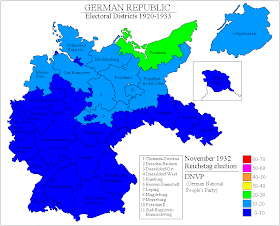It's hard to speculate as to what the current Germany would have been like if Adolf Hitler had not come to power. WW2 was a disaster for Germany on so many levels. It's doubtful that Germany would have engaged in a world war if Hitler had not come to power and therefore the forces which gave rise to him are of significant interest. Germany was not committed to militarism, even after years of suffering under the injustice of the Versailles Treaty, but the treaty itself, and the Depression provided an environment in which radicalism could thrive.
This next series shows the development of the Nazi vote from 1924-1934 within the background of the social forces previously mentioned.
Firstly, a graphic showing the distribution of German Catholics vs Protestants int the 1934 Census.
The darker the area, the more Catholics.
Next, the Nazi vote in;
1924:
1928:
1930:1932:
Here's the 1934 Census again. The darker the area, the more Catholic it is:
The Communists, they seemed to get some love;
But the other main competitor to the Nazi's for the hearts and minds of Protestants were:
The Socialists!!
Here's the religious map again.
The Protestant vote was split between the powerful anti-traditional forces of Socialism and Fascism with a smattering of Communism. Way to go Team Luther!! In fact, the Protestant vote for the Nazi's was greater in the July 1934 election, but it appears that they started to get a little scared of Hitler and when the November vote came, directed approx two million votes away from the Nazi's to the Socialists and Communists!
Only 10-20% of Protestants seemed to reject the new radicalism and directed their vote to the German National Peoples Party. This party was comprised of the deep social conservatives of Protestantism and it attracted about 10% of the vote up North.
It's party members were initially sympathetic to the Nazi's but after a while saw that they were completely nutty and crossed over to support the Catholics against Hitler!
The graphs were obtained from this site.










Besides protestants, who were the nazis main supporters?
ReplyDeleteThat would be anyone else in Germany who supported the Nazi's. Dumb Catholics, Atheists and apparently, early on, there were even some Jewish supporters, according to Kuehnelt-leddihn.
ReplyDeleteAccording to Friedrich Reck-Malleczewen, who lived through it and keep a secret diary (published as "Diary of a Man in Despair"), the most enthusiastic supporters of Naziism included low-level government employees (post office workers, etc) and teachers. Also, I don't have time to dig up the links at the moment, but there was pretty heavy female support for the Nazi party.
ReplyDeleteA very interesting piece from Atlantic magazine from 1935 on the psychological/philosophical roots of Naziism:
http://www.theatlantic.com/magazine/archive/1935/02/swastika/8959/
@Owner.
ReplyDeleteThanks for Reck-Malleczewen tip. I ordered his book from Amazon today. Looks very interesting.
You might find this article interesting as well. The Nazi rot permeated all strata of German Society,. Yes, and I'm aware that Hitler was the object of erotic interest for many German females.
"Owner" was me....Google apparently decided to identify comments by the profile name rather than the blog name or the person's name.
ReplyDeleteThe best book I've seen on the social climate in Germany between the wars is Sebastian Haffner's memoir, which I reviewed at length here:
http://chicagoboyz.net/archives/11181.html
@ David
ReplyDeleteIt's a good book.
What about Italy, which started the fascist left trend. Way to go, Team Pope. ;)
ReplyDeleteIt`s good discussion however I think the war was inevitable, had Germany rejected Hitler (something conventional wisdom supports) they would have been invaded anyway by the Soviet Union which after murdering tens of millions of its own people was about to unleash its force in Europe. The evidence of this fact has been growing and has gained very serious Supporters in the Schools of History (Suvorov, Stauss to mention just a few).
ReplyDeleteYou can check this site to get started in the argument: http://www.ihr.org/jhr/v19/v19n6p40_Michaels.html
@Anon
ReplyDeleteI'm aware of the historical argument.
I do think war was inevitable even if Hitler had not come to power, but the then in would have been U.S. vs U.S.S.R 1943. With U.S. nukes.
It' would have been bloody but Communism would have died.
@Valkea
ReplyDeleteSorry, somehow I missed out giving you a reply.
I've had a look at the 1932 elections again. 84% of eligible voters turned out and the Nazi's received 37% of the votes. That means that 31% of Germans specifically wanted a Nazi leadership.
In the 1924 elections, when Mussolini came to power, only 64% of Italians turned out. The National bloc received 65% of all cast ballots. Therefore 41% of Italians voted for it. But the National Bloc was a coalition made up of various ideologically disparate right wing parties. If we assume that approx 60% of people who voted for the National Bloc voted directly for the fascists (a very high and unlikely figure based on my reading) then roughly 25% of Italians voted for the fascists directly. After getting into power Mussolini neutralised the coalition and made himself Il Duce.
As for Fascism itself, it was highly anti-clerical, Mussolini only got any traction after he assured the Church its demands. The Church halfheartedly sided itself with Mussolini only because it felt that compared to the socialists he was the lesser evil. They were correct in my view because even though the Fascists were vile, they were less vile than the communists.